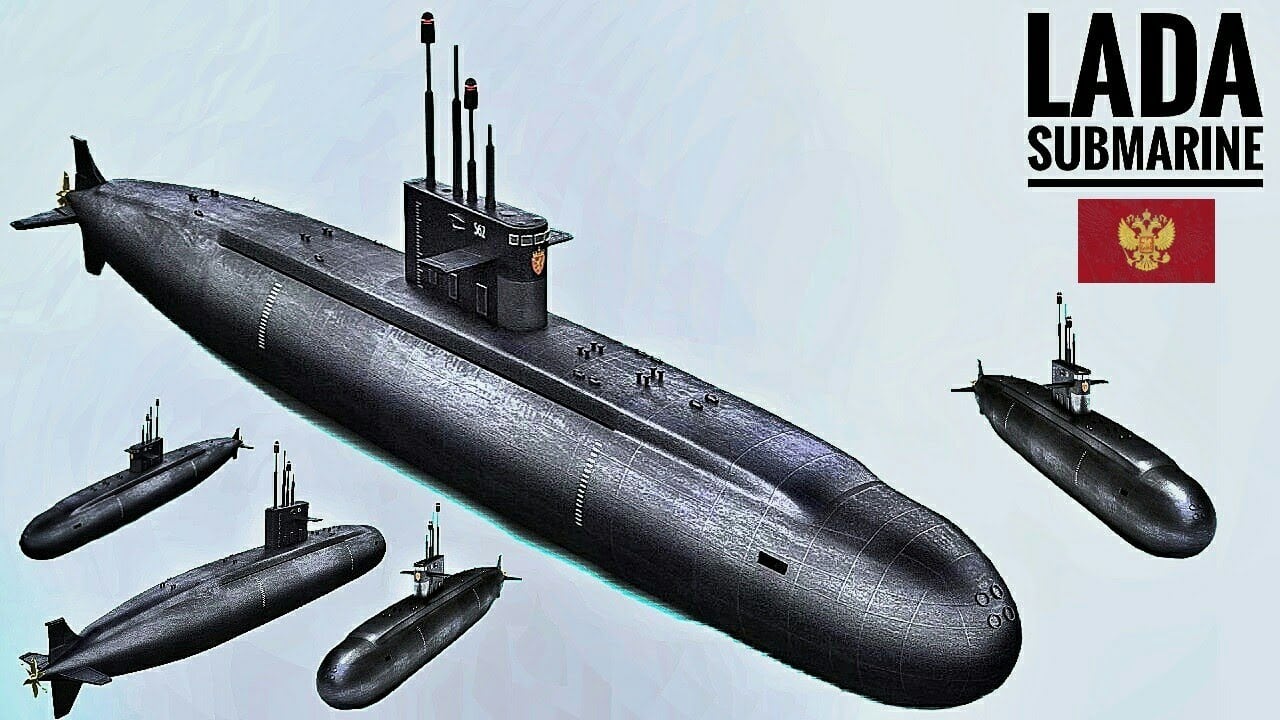Russia’s Lada-class, also known as the Project 677 family of submarines, is a class of diesel-electric submarines designed and developed for the Russian Navy as a replacement for the Cold War-era Kilo-class submarines.
The design emphasizes automation, an advanced sensor suite, and stealth.
The Lada-class follows the earlier Kilo-class, which it was intended to supplant — though Russia still operates Kilo-class submarines—and builds on their capabilities as smaller, more compact attack submarines—not intended to take the mantle of launching Russia’s nuclear arsenal at the United States or other targets, but rather to stay closer into Russian home waters and defending the coasts, attacking enemy shipping, and other surface combatants as well as hunting down other enemy submarines.
As one naval expert noted, the Lada-class’s “main strength is likely to be the sonar. The bow of the submarine is wrapped in a conformal array, likely the biggest of any non-nuclear submarine. How effective its computers will be at analyzing the mass of data such a large array should generate is open to question. But it does imply an impressive anti-submarine capability.”
The Sankt Peterburg
The lead sub of the Lada-class, the Sankt Peterburg, named after Russia’s far-north city, was commissioned in 2010.
Hope for the submarine was high as the first of a capable new class of fourth-generation subs.
Despite a painfully prolonged construction period — the ship was first laid down in 1997 and finished in 2004 — the Sankt Peterburg was commissioned by the Russian Navy in 2010.
But all was not well.
Shortly after commissioning in the Russian Navy, it was discovered that both the submarine’s sonar and propulsion system were deficient, necessitating an overhaul to the Lada-class design.
While the Sankt Peterburg did join Russia’s Northern Fleet in 2014, a subsequent 2023 modernization program that would have enhanced the submarine’s capabilities was deemed more expensive than simply scrapping the submarine and starting afresh.
Russia’s state-owned TASS news agency reported in 2023 that the Russian Navy would decommission the Sankt Peterburg, the lead of the Project 677 Lada-class submarines.
“According to unnamed industry and shipbuilding sources quoted by TASS, the proposed modernization was extremely expensive,” as per Janes, “and the Russian Navy had concluded that the funds would be better spent on procuring a newbuild submarine.”
“Sankt Peterburg was laid down at Admiralty Shipyards in St Petersburg in December 1997 and launched in October 2004. Since its commissioning in 2010, it has been involved in trials activities with the Northern Fleet that were scheduled to be completed in 2017, although reports suggest that this did not happen.
In April 2020, Sankt Peterburg arrived at the Kronstadt Marine Plant for the modernization program, which has now been canceled.”
In February of 2024, the Russian Navy commissioned the Kronstadt, the second of the Lada-class submarines. “Speaking at the ceremony, which was announced by Admiralty Shipyards the same day, RFN Commander-in-Chief Admiral Nikolai Yevmenov said that Kronstadt would be assigned to the Northern Fleet,” Janes explained.
“This follows earlier speculation that Kronstadt and some or all or subsequent boats in the class would be deployed to the Baltic to rejuvenate that fleet’s moribund submarine capability.”
Like the earlier Sankt Peterburg, the Kronstadt’s roll-out was also plagued by difficulties and delays. Work began on the submarine in 2005 but stopped in 2009. Work started again in 2013, and the sub launched in 2018. It went through trials in 2021 and 2022.
Lada-Class: Open for Export?
Russia has offered a version of the Lada-class for export on the open market, the Amur-class submarine in several variants.
Though broadly similar to the Lada-class, the export-oriented Amur-1650 is somewhat larger and intended for longer-endurance missions.
In contrast, the Amur-950 is armed with a Vertical Launch System (VLS) to attack land targets. Interestingly, neither of the export models is certified for operations through solid ice at the poles — though not likely to be a drawback to countries that import submarines rather than design their own.
Though Russia made a bid to India for the joint build of Amur submarines, the Indian Navy opted instead for a French design due to concerns about the slow build pace for the Russian submarines, and to date, no foreign country operates the Amur-class.
What Happens Now?
Though the development of the Russian Navy’s Lada-class continues, the Russian Navy also operates the newest Kilo-class submarines, their 636.3 Kilo-class subvariant, highlighting the difficulties with their rollout.
Considering the problematic Lada-class rollout, Russia’s newer Kilo-class submarines will see active service for many more years.
About the Author: Caleb Larson
Caleb Larson is an American multiformat journalist based in Berlin, Germany. His work covers the intersection of conflict and society, focusing on American foreign policy and European security. He has reported from Germany, Russia, and the United States. Most recently, he covered the war in Ukraine, reporting extensively on the war’s shifting battle lines from Donbas and writing on the war’s civilian and humanitarian toll. Previously, he worked as a Defense Reporter for POLITICO Europe. You can follow his latest work on X.

